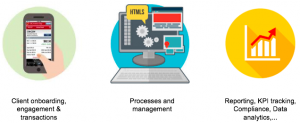Today, more than two thirds of the world population are connected to mobile services. This simple fact makes digital financial technology a key component of revolutionizing financial inclusion efforts. Digital transformation initiatives are being put in place at a growing pace in both emerging and developed markets to streamline banking and microfinance processes and better cater to the needs of the un(der)banked, while increasing operational efficiency. Those initiatives entail a profound and strategic transformation, at the organizational level, of all operational activities, processes, competencies and models to fully leverage the potential of digital technologies and ecosystems. They can be implemented at a process level, such as using Digital Field Applications (DFA) for loan processing, or at the transactional level, where we then talk about using a digital channel, such as the mobile, to offer Digital Financial Services (DFS).

Digital transformation initiatives are very often led by banks in collaboration with Fintech companies, allowing them to offer practical, and increasingly cheaper financial products and services to their clients. Meanwhile, most Microfinance Institutions (MFIs) find themselves on the sidelines of the digital revolution and still face high costs, low earnings, and difficulties expanding efficiently, especially to remote areas. Even if an increasing number of them recognize the huge potential of digital transformation, the majority has yet to dive into the digital world. However, any MFI wishing to remain sustainable and competitive in this fast evolving landscape, will urgently have to consider what digital solutions they could viably put in place.
By undertaking digital transformation, automating key processes and offering DFS, MFIs can achieve significant costs optimization over time. Though initial investment can be high, costs will ultimately go down thanks to gains in operational efficiency. Loan disbursement and repayment using digital technology, combined with an efficient agent network, has proved to be a faster and cheaper way of giving out credit to the unbanked. For example, Ujjivan Small Finance Bank Ltd in India achieved a 40% reduction in loan treatment time and a 50% increase in the number of loans per officer by partnering with a fintech, Artoo, and providing tablets linked to a cloud-based central system to their loan officers. Ujjivan also leveraged Artoo’s expertise in alternative credit scoring allowing for automated credit scores based on data analytics. Another example is Financiera Fundeser in Nicaragua. The MFI implemented iCredit, a DFA given to loan officers that helps capture client data on the ground and is connected to the credit bureau used by Fundeser, which allows the client’s score to be obtained in less than a minute.
Overall, the MFI industry is seeing a trend of using tools to automate loan processes and also figuring out ways to use data for quicker and more wholesome scoring mechanisms. The resulting cost optimization can also trickle down to the customer in the form of reduced interest rates or quicker turnaround time for loan processing, which increases customer satisfaction. Additionally, as MFIs adopt agent networks and digital channels, there is more convenience for the customer. He/she is able to save a significant amount of time and money by accessing the service remotely on his/her phone or at an agent point nearby. He/she also benefits from a lower waiting time at the MFI branches, as more and more customers are diverted to the digital channel. This also decreases risks by reducing the need for clients and loan officers to handle cash on a regular basis.
MFIs can further reduce their costs by implementing digital initiatives which incentivize clients to save more, therefore decreasing the need for external funding and its associated costs. These initiatives range from using a well spread agent network – allowing clients to make deposits (and other transactions), near their residence or place of work – to mobile applications such as Bangladeshi Sajida foundation’s Financial Advisory Services tool – guiding loan officers through structured conversations around savings with specific clients.
DFS can also help MFIs achieve increased financial inclusion, by enabling penetration to remote areas and catering to clients with low financial education. MFIs’ experience in reaching low-income populations gives them a significant advantage over traditional banks, which often have a hard time downscaling. Additionally, their license gives them an advantage over MNOs since it allows them to offer products, such as credit and, in some cases, remunerated savings, which MNOs cannot usually provide without a financial institution partner.
However, if digital transformation can provide all those benefits, then why hasn’t it already been widely adopted by the microfinance industry? Find out in Part 2 of this blog post!